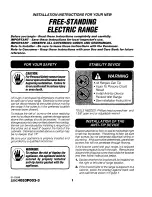
13
a. Remove the trivets from the top of the
appliance, taking note that the trivets are
manufactured with a lip on one edge, the lip
must always be fitted to the outer edge (front
and back) of the Range.
b. Remove the burner cap and burner complete
with venturi tube, from the top of the range
manifold, taking care not to damage the
thermocouple fitted to the mounting rail. (Fitted
to Flame Failure Models Only).
c. The trivets and burners should be cleaned with a
mild detergent and hot water solution using a
soft bristled brush. Dry thoroughly with a dry
cloth.
a. Remove all the trivet supports from the top of
the range. Take note of the orientation of the
trivet support when removing. The trivet support
front side rail profiles are different from the rear
side rail profiles.
b. The trivet supports should be cleaned with a mild
detergent and hot water solution using a soft
bristled brush.
c. Dry the trivet supports thoroughly with a dry
cloth.
NOTE:
On units fitted with Flame Failure Thermocouples as
standard or as an option, the Mounting Rail is Not
removable for cleaning and no attempt should be
made to remove this rail.
a. With the griddle plates and burners removed,
clean the interior and exterior surfaces of the
Range with hot water, a mild detergent solution
and a soft scrubbing brush. Note that the gas
control knobs are a push fit onto the gas control
valve spindles and can be removed to allow
cleaning of the front of the control panel.
b. Baked on deposits or discolouration may require
a good quality stainless steel cleaner or stainless
steel wool. Always apply cleaner when the
appliance is cold and rub in the direction of the
grain.
c. It should not be necessary to remove the splash
guards covering the burner manifolds for
cleaning purposes. These can be cleaned in
situ.
d. Dry all components thoroughly with a dry cloth
and polish with a soft dry cloth.
e. Remove the grease tray and clean with a mild
anti bacterial detergent and hot water solution
using a soft bristled brush.
f. Dry the grease tray and all components
thoroughly with a dry cloth and polish with a soft
dry cloth.
a. Clean the Range cooking area using a soft cloth
moistened with a mild detergent and hot water
solution.
b. Baked on deposits or discolouration may require
a good quality stainless steel cleaner or stainless
steel wool. Always apply cleaner when the
appliance is cold and rub in the direction of the
grain.
c. It should not be necessary to remove the splash
guards covering the burner manifolds for
cleaning purposes. These can be cleaned in
situ.
d. Remove the grease / spill tray(s) and clean with
a mild anti bacterial detergent and hot water
solution using a soft bristled brush. Dry the
grease spill tray(s) thoroughly with a dry cloth.
NOTE:
In order to prevent the forming of rust on the griddle
plate, ensure that all detergent and cleaning
material has been entirely removed after each
cleaning process. The appliance should be
switched on briefly to ensure that the griddle plate
becomes dry. Oil or grease should be spread over
the griddle surface in order to form a thin protective
greasy film.
a. Remove and clean the grease / spill tray(s)
frequently to prevent over spills.
b. Clean the griddle surface thoroughly with a
scraper tool or a wire brush. If necessary use a
griddle stone or a scotch bright pad on the
griddle surface to remove stubborn or
accumulated carbon deposits.
c. A scraper tool can be used for the removal of
stubborn carbon and deposits.
d. Occasionally bleach the griddle plate with
vinegar when the plate is cold.
e. Clean with hot water, a mild detergent solution
and a scrubbing brush. Dry all components
thoroughly with a dry cloth.
f. The Range should be switched on briefly to
ensure that the griddle plate becomes dry.
A thin smear of cooking oil should be spread
over the grates in order to form a protective film.
Summary of Contents for CR6 Series
Page 28: ......














































